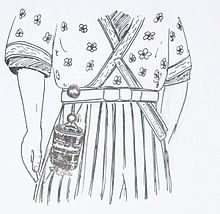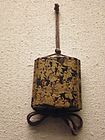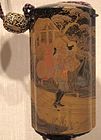Contents
[hide]Description[edit]
Because traditional Japanese garb lacked pockets, objects were often carried by hanging them from the obi, or sash, in containers known as sagemono (a Japanese generic term for a hanging object attached to a sash). Most sagemono were created for specialized contents, such as tobacco, pipes, writing brush and ink, but the type known as inrō was suitable for carrying anything small.
Consisting of a stack of tiny, nested boxes, inrō were most commonly used to carry identity seals and medicine. The stack of boxes is held together by a cord that is laced through cord runners down one side, under the bottom, and up the opposite side. The ends of the cord are secured to a netsuke, a kind of toggle that is passed between the sash and pants and then hooked over the top of the sash to suspend the inrō. An ojime, or bead, is provided on the cords between the inrō and netsuke to hold the boxes together. This bead is slid down the two suspension cords to the top of the inrō to hold the stack together while the inrō is worn, and slid up to the netsuke when the boxes need to be unstacked to access their contents. Inrō were made of a variety of materials, including wood, ivory, bone, and lacquer. Lacquer was also used to decorate inro made of other materials.
Inrō, like the ojime and netsuke they were associated with, evolved over time from strictly utilitarian articles into objects of high art and immense craftsmanship.
平たい長方形をしており、素材は木製または金属製で3段から5段くらいに分割できるようになっている。各段の両脇に紐(緒締め=おじめ)を通して、先端には滑り止めの根付けを取り付け、紐を帯に挟んで使用した。特に螺鈿や蒔絵などが施されたものもある。
ギャラリー[編集]
転義[編集]
「いんろう」という言葉は、転じて以下の意味にも使われる。
- 建築や機械の分野では、外から見た接合面に隙間が無く、内部が位置決めや荷重を受ける働きを持つ構造をインローと呼ぶ。
- 日本料理用語で、野菜やイカなどの中心部に具を詰め込むことを印籠(射込み)と呼ぶ。稲荷寿司も、油揚げの中に飯を詰め込んだ印籠寿司の一種である(重金敦之『すし屋の常識・非常識』24p)。
関連項目[編集]
- 水戸黄門 - 印籠を振りかざしての「この紋所が目に入らぬか!」の決め台詞で知られる、長年に渡って放映された時代劇テレビドラマシリーズ。












沒有留言:
張貼留言